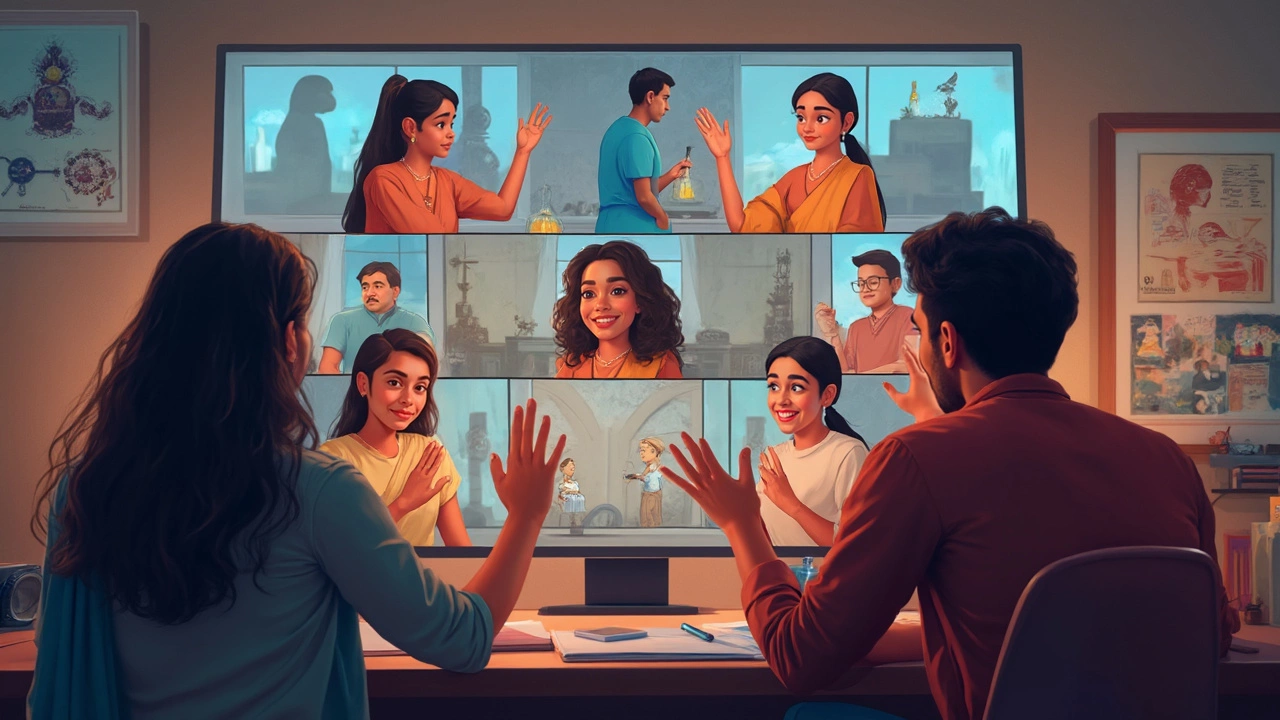
Distance education isn’t just studying while sitting at home in pajamas (although, let’s be honest, that’s one of the perks). It’s a way of learning where you don’t need to be physically present in a classroom. You can pick up new skills, complete degrees, or just learn something fun—all from wherever you feel comfortable.
This setup is a lifesaver for anyone who has work, family commitments, or just lives too far from the place offering the course. Plus, you don’t have to worry about rushing to catch a bus or searching for parking every morning. Instead, you log in, get materials, join live or recorded sessions, and work through assignments when it fits your schedule.
But it’s not just videos and reading. Real distance education includes back-and-forth with teachers—think live classes, group chats, email feedback, and discussion boards. With the right approach, you can feel part of a real learning community, even if everyone’s halfway across the world.
- Defining Distance Education Simply
- How Distance Education Works Day-to-Day
- Main Tools and Platforms Used
- Tips for Getting the Most Out of Distance Learning
Defining Distance Education Simply
When people talk about distance education, they mean any learning that happens with the teacher and student in different physical places. You don’t need to sit in a classroom to join a lesson or finish assignments. This model started way back in the 1800s with old-school mail courses—people would get lessons by post, send their answers back, and wait weeks for feedback. Today, it’s mostly digital and a lot faster thanks to the internet and smartphones.
The key points? Education happens away from the actual campus, you use tech like video calls, emails, or apps, and you’re not tied to a fixed classroom or schedule. Some programs are totally online while others mix in-person and virtual learning—this part is called “blended learning.”
| Type | How It Works | Example |
|---|---|---|
| Fully Online | All lessons and tests happen digitally. | Online universities, language apps |
| Blended | Mix of online work and some in-person classes. | Community colleges with online modules |
| Correspondence | Materials and assignments sent by mail (rare now). | Old GED programs |
The crazy part? According to a 2023 report by the National Center for Education Statistics, about 60% of college students in the U.S. took at least one distance course. This shows just how normal remote learning has become.
If you’re looking for more flexibility—because maybe you have a job, family, or other stuff going on—distance education can make higher education possible when it otherwise wouldn’t be. No wonder it’s getting more popular every year.
How Distance Education Works Day-to-Day
So, what actually happens when you sign up for distance education? It isn’t just a one-way street where you get a pile of reading and disappear until the final test. The day-to-day flow keeps you connected, organized, and moving forward, even if your classmates are in totally different cities, or even countries.
Most distance education programs use an online platform, like Moodle, Canvas, or Google Classroom. This is your home base where you’ll find lectures, readings, assignments, and announcements. Schools usually organize the week around a clear schedule, but there’s a big difference: you can usually decide when to get stuff done, as long as you hit the deadlines.
Here’s what a typical week might look like for a distance learner:
- Log in daily: Check messages from your teachers, upcoming due dates, and group chats or forums where classmates might post questions or helpful tips.
- Watch or attend lectures: Sometimes, you’ll have live video classes where you can ask questions on the spot. Other times, lectures are recorded so you can watch whenever you’re ready—with the power to pause and rewind when things get confusing.
- Complete assignments: Upload essays, quizzes, or projects straight onto the platform. You might even work in digital study groups, sharing files or meeting on video calls.
- Communicate often: Distance education doesn’t have to feel lonely. Teachers and classmates connect over discussion boards, emails, or chat groups. Some teachers even hold virtual office hours for live help.
No one’s looking over your shoulder, so time management is everything. Setting up a daily study routine helps. A lot of people find it useful to block out regular times (like every evening after dinner) to check lessons, work on tasks, and chat with classmates. Having a set routine builds a good learning rhythm and makes it less likely you’ll fall behind.
Tech problems pop up sometimes. Before panicking, ask your teacher or school’s help desk—they expect these questions and have guides or fast fixes ready. And don’t be shy about reaching out; a quick question can save hours of frustration.

Main Tools and Platforms Used
If you’ve done distance education or maybe just peeked over a friend’s shoulder, you’ve probably seen a bunch of digital tools at play. Some are simple, like video calls, and others are packed with features like tracking your progress, chatting with classmates, or turning in assignments right from your phone.
The top platforms most schools and colleges use are:
- Moodle: This is like a virtual classroom where teachers post materials, quizzes, and updates. It’s super common because it’s open-source, so schools can tweak it as they see fit.
- Google Classroom: Tons of teachers use this one, especially after 2020. You join a class with a code, get assignments, turn in work, and even leave comments for your teacher or classmates.
- Zoom and Microsoft Teams: These tools are the go-to for live video classes. People love them because you can raise your hand, send chat messages, or even jump into breakout rooms for group work.
- Canvas and Blackboard: Mostly used by colleges, these put everything in one dashboard: homework, grades, class discussions, and resources.
Some platforms are booming: As of late 2024, Zoom’s user base was sitting around 300 million daily meeting participants, and Google Classroom counted over 150 million users worldwide.
| Platform | Primary Use | Estimated Users |
|---|---|---|
| Moodle | Course management, quizzes | Over 300 million |
| Google Classroom | Assignment sharing, grading | 150 million |
| Zoom | Live video classes | 300 million |
| Canvas | Full course management | 30 million |
Beyond the big names, students rely on cloud storage (like Google Drive), chat apps (like WhatsApp or Slack for group projects), and even mobile learning apps for bite-sized lessons. A lot of instructors record lectures and upload them to YouTube or private course sites, so you can watch when it suits you. It’s not about the fanciest tech—it’s about finding what makes connecting and learning easy for everyone involved.
Tips for Getting the Most Out of Distance Learning
There’s a knack to making distance education really work for you. Don’t just wing it; some small changes can level up your experience fast.
- Create a regular routine. Set a specific study schedule—even if it’s just half an hour in the evening. People who stick to routines are way more likely to hit their goals.
- Set up a dedicated study spot. It doesn’t have to be fancy. Clear a small table of distractions and make it your go-to learning space. Even a corner with good lighting can help you focus.
- Use a planner or an app. Deadlines sneak up, especially when you’re managing your own time. Apps like Google Calendar or Todoist make tracking assignments and live sessions simple.
- Get involved in group chats or forums. Online courses with strong community support see higher completion rates—one massive study from Coursera showed completion can double when students engage with peers.
- Talk to your instructors. Don’t hesitate to ask questions via email or discussion boards. Instructors are used to working online and usually answer pretty quickly.
- Take breaks and move. Every hour, walk around for five minutes or stretch. It refreshes your brain and keeps your energy up.
- Tech check! Test your internet and know how to troubleshoot basic problems. Universities often say over 40% of support requests are for connection issues and login problems—sort these out early so you're not stuck later.
Here's a quick look at some data showing what boosts success in distance learning from a 2023 survey by the National Center for Education Statistics:
| Factor | Reported Completion Rate Increase |
|---|---|
| Using Study Schedules | +28% |
| Instructor Interaction | +18% |
| Peer Collaboration | +22% |
| Dedicated Study Space | +14% |
If you ever get discouraged, remember, even people balancing full-time jobs or raising kids have managed to finish big online courses. My friend James, who’s got three kids and a crazy work schedule, finished his coding certificate completely online. He swears by using voice notes for quick reminders and having Saturday morning “study dates” with his oldest.
Don’t overthink it—distance learning is like anything else; a bit of structure and a willingness to reach out when you’re stuck go a long way.
